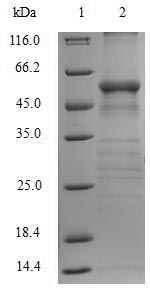Entire Human Arginase-1/ARG1 cDNA (1-322aa) with an N-terminal GST-tag was expressed in E.coli. The forming protein is the Recombinant full-length Human ARG1 protein. The purity of this protein is greater than 90% as determined by SDS-PAGE. Under reducing conditions, the SDS-PAGE gel showed a molecular weight band of about 62 kDa. This recombinant ARG1 protein may be used for specific antibody production or in the studies of ARG-1-related signal transduction.
ARG1 is the last enzyme in the urea cycle and it promotes the conversion of arginine to urea and ornithine. Deficiency of ARG1 causes hyperargininemia/arginase deficiency, an autosomal recessive urea cycle disorder, in which the increased arginine levels result in toxicity. High ARG1 expression has been found in several cancers, such as breast cancer and colorectal cancer. Malgorzata Czystowska-Kuzmicz etc. demonstrated that ARG1 is expressed in ovarian tumors and facilitates ovarian carcinomas (OvCa). The levels of ARG-1 is related to poor prognosis. ARG1 is carried by OvCa-derived small extracellular vesicles (EVs). EVs carrying ARG1 contribute to systemic immune suppression in OvCa patients and suppresses T-cell proliferation in vitro.




